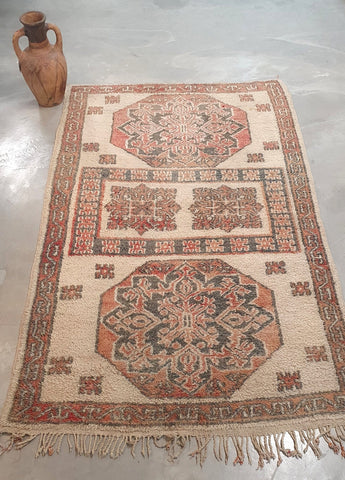When it comes to decorating a home, rugs are a great way to add character and warmth to any room. Many people, however, do not know the difference between Berber and Moroccan rugs though often Berber rugs can still be Moroccan as there are Berber tribes in the Atlas mountains of Morocco still producing rugs.
What does Berber mean? Berber is a term referring to numerous indigenous ethnic groups in North Africa. These groups, who generally speak the Berber languages, are spread over a large geographical area, including Algeria, northern Mali, Mauritania, Morocco, northwestern Niger, Tunisia, Libya, and the Canary Islands.
Both Berber and Moroccan made rugs offer a timeless elegance and are perfect to give any room an updated and sophisticated feel, though usually the material and design do vary (and note we are only referencing the Berbers of the Atlas mountains)
Hand-Knotted Berber Rugs
Standing the test of time Berber Rugs are all hand-knotted. Hand-knotted Berber rugs are often crafted by skilled artisans who employ time-honored techniques to create a refined and luxurious look that can add sophistication to any space. Hand-knotted Berbers are usually made with a natural or recycled wool pile, cotton or Jute and feature low, dense loops for a plush finish. The knots of the rug often feature a geometric or tribal pattern, which is a signature characteristic of Berber carpets. The most popular hand-knotted Berber carpets often feature intricate details such as fringes, tassels and bold colors, adding to its unique appeal. As for there design they typically feature an intricate geometric or diamond pattern, surrounded by a solid or two-color border. The geometric designs usually cover the entire rug. The most commonly used colors in Berber rugs are navy blue, ivory, red, and brown. Berber rugs are extremely durable, and are often used in high-traffic areas in the home, such as the living room or hallway.

Moroccan Berber Rugs
In contrast to hand-knotted Berber carpets, Moroccan Berber rugs are made by professionals who use various traditional methods and equipment like looms. Moroccan rugs are typically made with wool and or silk and feature a heavy pile with short, tightly-packed loops. Berber carpets with Moroccan origin are often designed with earthy colors, tribal patterns and intricate fringed edges and are often adorned with metallic thread, which gives the rug an added richness. Known for their boldness, Moroccan rugs can bring an exciting and unique look to any room.

When considering which type of rug is best for your home, it is important to consider both the design and the durability of the rug. Berber rugs are known for their practicality and durability, making them a sensible choice for high-traffic areas of the home. However, if you are looking for a rug to be a statement piece or to add a unique flair to your home, a Moroccan rug may be the better choice.
In terms of cost, Berber rugs are generally less expensive than Moroccan rugs, but since the production of these rugs is a complex process, they tend to be more expensive to buy. Moroccan rugs, however, are often considered more of an investment and can cost thousands of dollars. The price of a Moroccan rug is typically determined by the quality of the materials, the craftsmanship and the complexity of the design.
Adding a Boujaad or M'rirt to Your Home
There are many traditional Rugs you may want to consider for your home. A Boujaad and a M’rirt are both types of vintage Moroccan rugs that offer an authentic and vibrant style. A Boujaad is a type of rug that is hand-woven on a vertical loom, while a M'rirt, or M'guild, is a rug made from thick wool with a low pile and is commonly known for its red and blue geometric patterns.
A Kilim for a Contemporary Style
If you’re looking for a more contemporary style, a Kilim is an excellent option. Kilim rugs are flat, reversible pieces made with a single piece of weft-faced fabric. These pieces often feature intricate patterns and bold colors. Many of these are created from wool, cotton or both, and feature hand-knotted detailing for an added elegant touch.
Looking for more information on the types of Moroccan Rugs, check out our other article here.
When shopping for a Berber or Moroccan rug, there are a few things to consider before making your purchase. First, consider the size of the room and how much of the floor you’d like to cover. Also, consider the color scheme of the room and find a Berber rug that best complements your décor. Finally, consider your budget and find a rug that’s within your price range. With all these factors in mind, you’ll be sure to find the perfect Berber carpet to upgrade your home décor.
In conclusion, when you’re shopping for the ideal Berber rug for your home, you should consider the various types on the market. Be sure to consider the size of the space, the color scheme, and your budget before making your purchase. With every hand made rug having its own personality, you can create a timeless, sophisticated and elegant atmosphere in any room.

Leave a comment